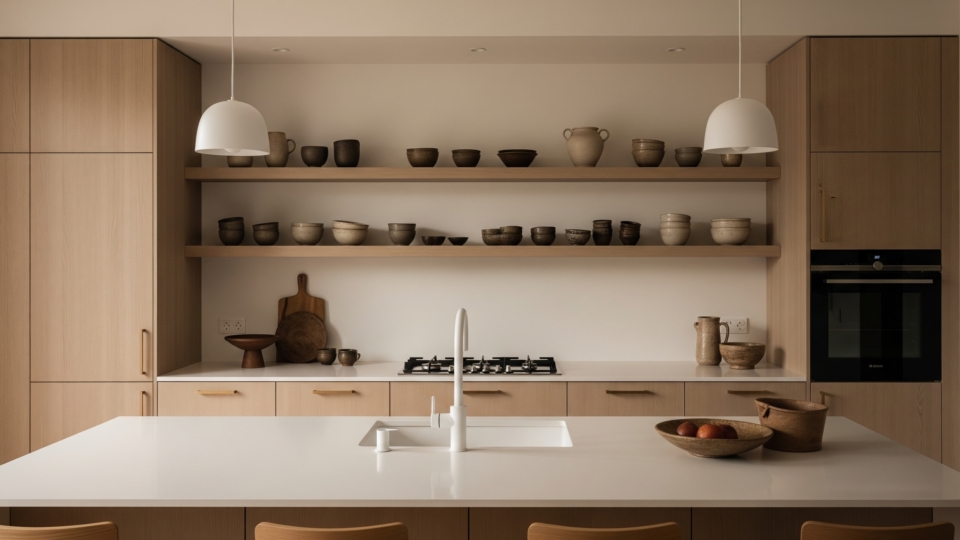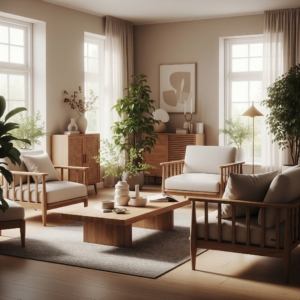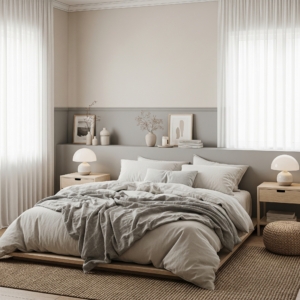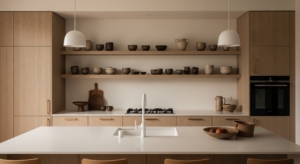
The Rise of Japandi Style in 2025 Interiors
If you’ve flipped through a design magazine or scrolled Instagram in 2025, you’ve likely encountered the Japandi style. Muted and minimal yet warm and comforting, Japandi interiors are popping up everywhere from trendy city apartments to tranquil country homes.
This East-meets-West design fusion is capturing the imagination of design-savvy homeowners and upscale renovators alike. In this article, we’ll explore what Japandi style is, why it’s skyrocketing in popularity in 2025, and how you can infuse this serene, aspirational look into your own home.
What is Japandi Style?
Japandi style is a hybrid interior design trend that beautifully blends Japanese minimalism with Scandinavian comfort. The name “Japandi” itself is a portmanteau of Japanese and Scandi. At its core, Japandi combines the Zen-like simplicity of traditional Japanese interiors with the cozy functionality of Scandinavian design (often associated with the Danish concept of hygge, or comfort). The result is an aesthetic that feels minimalist, natural, and serene, without ever being cold or stark.
Architectural Digest calls the look “calm, casual, and organic” (Architectural Digest). In other words, Japandi rooms are clean and uncluttered but also warm and inviting. You might see a Japandi living room with low-profile, clean-lined furniture, a soft neutral rug, and a few well-placed accessories like an artisanal ceramic vase or a lush green plant. Every piece serves a purpose; decor is intentional and understated rather than purely decorative.

Origins of Japandi: Though it feels very “now,” Japandi isn’t an overnight fad. It’s rooted in a long-standing cross-cultural appreciation. Designers in Scandinavia have been inspired by Japanese aesthetics for over a century, drawn to shared principles like simplicity and craftsmanship. (In fact, the Japanese concept of wabi-sabi. Finding beauty in imperfection.
Aligns closely with the Scandinavian love of humble, cozy interiors.) The term “Japandi” emerged in design circles in the late 2010s as this fusion gained mainstream popularity. By the early 2020s, magazines and blogs were buzzing about this East-West mashup of styles, and now in 2025 it has fully arrived as a mainstream interior design trend.
Key Characteristics of Japandi Style: What exactly defines a Japandi interior? Here are the hallmark features of this style, which set it apart from other design trends:
- Minimalist Design, Cozy Feel: Japandi embraces the “less is more” ethos – spaces are clutter-free and focused on essentials – yet rooms don’t feel sterile. The Scandinavian influence adds a sense of hygge (coziness), so even minimal spaces feel comfortable and livable.
- Natural Materials: Organic, high-quality materials are at the forefront. Expect lots of wood, from light Nordic birch to darker Japanese oak, along with bamboo, rattan, stone, and linen textiles. These materials bring warmth and texture while staying true to nature.
- Neutral, Calming Colors: Japandi color palettes are neutral and earthy. Think whites, creams, soft grays, beiges, and muted browns or greens. Bold colors are used very sparingly, if at all. The overall mood is calm and muted, creating a tranquil atmosphere.
- Craftsmanship and Quality: Rather than fast furniture or trendy throwaways, Japandi spaces favor well-crafted pieces. Handmade ceramics, heirloom-quality wooden furniture, and artisanal touches reinforce the value of quality. Every item has a purpose and a story, lending a sense of authenticity.
- Bringing Nature Indoors: A connection to nature is key. Large windows inviting in natural light, indoor plants or simple arrangements of branches, and natural fibers all help blur the line between indoors and outdoors. Japandi interiors often feel very zen, echoing a Japanese garden or a Scandinavian forest cabin.
These elements work in harmony to create Japandi’s signature balanced look. Where purely Japanese interiors might be very sleek and sparse, and purely Scandinavian ones can be rustic and homey, Japandi finds the sweet spot: clean lines and open space combined with soft textures and organic accents. The shared philosophy between the two cultures – an appreciation for simplicity, nature, and comfort. Makes the combination feel seamless.
Featured Snippet Definition: Japandi style is a minimalist interior design trend that blends Japanese zen aesthetics with Scandinavian hygge comfort. It’s characterized by clean lines, natural materials like wood and bamboo, neutral calming colors, and a cozy yet uncluttered look.
(The above definition offers a quick summary of Japandi style – ideal as a bite-sized answer for those wondering what Japandi is.)
Why Japandi Style is on the Rise in 2025
In the past couple of years, Japandi has evolved from a niche Pinterest inspiration to a leading interior design movement. 2025 has truly become Japandi’s breakout year. Here are a few reasons why this style is surging in popularity right now:

- A Shift Toward Simplicity (Minimalism Meets Comfort): Coming out of the chaotic early 2020s, many people are craving simplicity and calm in their homes. Japandi’s blend of minimalism and warmth scratches that itch perfectly. Homeowners are decluttering en masse and embracing more mindful, intentional decor. Yet unlike austere modern minimalism, Japandi doesn’t feel harsh – it softens the minimal look with comfy textiles, natural wood grains, and personal touches. This balance of clean and cozy is incredibly appealing to those who want order and comfort.
- Post-Pandemic Wellness and Serenity: After spending so much time at home, people now view interiors through a wellness lens. We want our living spaces to be calming sanctuaries that reduce stress. Japandi delivers on this front: the neutral colors, natural elements, and uncluttered layouts contribute to a sense of peace. In a Japandi bedroom, for example, the low platform bed, soft lighting, and simple furnishings can create a spa-like retreat ideal for relaxation. The popularity of mindfulness, meditation, and self-care in 2025’s culture ties in with Japandi’s serene vibe. Design-savvy individuals are gravitating towards this style as a way to make their homes feel like an oasis of tranquility in a busy world.
- Multi-Cultural Inspiration: There’s a growing appreciation for global influences in design. Japandi’s very DNA is multicultural – it’s the marriage of Eastern and Western design traditions. This aspect resonates in today’s diverse, connected world. By incorporating both Japanese and Scandinavian elements, Japandi interiors feel sophisticated and worldly. A home decorated in Japandi style might feature a mix of decor books on both Nordic design and Japanese tea ceremonies on the coffee table! Designers and homeowners love that Japandi celebrates the best of two cultures. It’s a trend that feels fresh yet timeless, thanks to its deep roots in design philosophies from across the globe.
- Social Media and Magazine Exposure: Japandi’s rise has been amplified by beautiful spreads in major publications and countless Instagram posts. You’ve probably seen those viral Japandi living room photos: slatted wood screens, a comfy linen sofa, a single leafy branch in a vase on a smooth oak table – garnering thousands of likes. Even mainstream outlets like Vogue have highlighted Japandi as “the minimalist, multi-cultural interior design trend that shows no sign of stopping” (Vogue). According to Google search data, interest in “Japandi style” hit an all-time high in early 2025 – a clear sign that this trend has gone mainstream. When an aesthetic is simultaneously gracing Architectural Digest features and trending on Pinterest, you know it’s reached critical mass!
- Sustainability and Natural Living: Another big factor in Japandi’s 2025 popularity is its alignment with the sustainability movement. Japandi’s emphasis on natural materials, quality over quantity, and timeless design means it naturally encourages eco-friendly choices. Instead of fast-furniture or synthetic finishes, you’ll see renewable woods, organic cottons, and long-lasting furnishings in a Japandi space. This dovetails with the broader push for green design in the 2020s. Homeowners are more eco-conscious and are seeking styles that reflect that. In fact, Japandi’s rise parallels the trend of using sustainable materials in interior design (Interior Design Trends 2025: Why Sustainable Materials Are Trending This Year). By choosing Japandi, people can create a chic look and feel good about its low environmental impact. It’s a win-win trend for style and sustainability.
How to Incorporate Japandi Style in Your Home

One of the great things about Japandi is that it’s highly livable. You don’t need to completely overhaul your home to get the look. Instead, focus on a few core principles and design choices that capture the Japandi vibe. Here’s how you can bring Japandi style into your own interiors:
- Embrace “Less is More”: Start with a minimalist mindset. Japandi rooms are free of excess clutter and unnecessary items. Go through each space and pare down to the essentials that serve a purpose or truly bring you joy. Clear surfaces and open up floor space. Opt for streamlined furniture with simple silhouettes. For example, in your living room, choose a low-profile sofa and a single coffee table rather than multiple side tables and ottomans. Keep decor accents to a thoughtful few. A simple painting or a vase on a sideboard is plenty. The key is to create breathing room in each area. When you remove the non-essentials, the pieces that remain can shine and the space instantly feels calmer.
- Use Natural Materials and Neutral Tones: To get the Japandi look, bring nature into your decor choices. Swap out glossy, artificial finishes in favor of organic textures. Think wood, stone, ceramic, bamboo, linen, cotton. For instance, you might replace a glass-top dining table with one in natural oak, or choose linen curtains instead of polyester. In the bathroom, consider wooden accents or stone countertops that give a spa-like, zen feel. Stick to a neutral color scheme inspired by nature: soft whites, warm beige, earthy taupe, sage green, or charcoal gray. A neutral base instantly creates that Japandi sense of calm. You can add subtle contrast through texture (a chunky wool throw on a smooth leather chair) rather than bold patterns. If you do introduce color, keep it muted. mMybe a dusty blue cushion or a mellow terracotta vase. Nothing too bright or saturated. The goal is a harmonious palette where no single element screams for attention.
- Blend Japanese and Scandinavian Décor Elements: Achieving Japandi is as much about mixing styles as it is about editing down. So combine the best of both worlds in your space. You could pair a sleek Japanese-style shoji screen or sliding door with a classic Scandinavian woven rug. Or place some Danish modern chairs at a table with a live-edge Japanese wood slab top. Marrying these elements creates that Japandi signature look. For decor accents, you might mix a few Japanese ceramics or a bonsai plant with Scandinavian touches like a knit cotton throw or minimalist art print. When choosing lighting, both cultures favor warmth – soft paper lanterns (Japanese) or simple pendant lights and candles (Scandi hygge vibes) work great. The trick is to ensure everything shares a similar color tone and simplicity. A rule of thumb: if an item is overly ornate or fussy, it probably doesn’t fit Japandi. Select pieces that have clean lines and a handcrafted feel, whether they come from Tokyo or Copenhagen.
- Prioritize Craftsmanship and Quality: In Japandi design, quality trumps quantity. Rather than having many pieces of furniture or decor, focus on a select few that are really well-made and meaningful. This might mean investing in a solid wood dining table that will last decades, or hunting for authentic vintage mid-century Scandinavian chairs. It could also mean showcasing handmade items: a gorgeous piece of pottery, a hand-loomed textile wall hanging, or any artisan-made furniture. The presence of craftsmanship adds soul to a Japandi room. You’ll notice many Japandi-inspired homes feature items that are either bespoke or have a bit of history. Perhaps it’s a restored Danish teak sideboard from the 1960s, or a new lamp from a local ceramic artist. By curating your space with fewer but higher-quality pieces, you not only achieve the aesthetic but also create a more sustainable, personal environment. A well-crafted piece also serves as a functional art object in the space. It’s beautiful, but it’s also built to be used every day.
- Bring Nature Indoors: Finally, don’t forget nature. It’s a vital element in Japandi interiors. Maximize natural light: keep window treatments minimal to let the sunshine in, which will make your neutral tones glow. Incorporate greenery, but in a restrained way. Instead of a dozen houseplants cluttering every corner, choose a few statement plants that suit the minimalist vibe. Great options are a tall dracaena or fiddle-leaf fig to bring height and life to a living room, or a simple tabletop arrangement of eucalyptus or cherry blossom branches in a ceramic vase. Natural motifs in art or decor can work too (think botanical drawings or a calm landscape painting) as long as they’re subtle. Even the views can be part of Japandi design – if you have a lovely garden or tree outside, arrange your layout to highlight that sightline. The idea is to create a synergy between indoors and outdoors so your home feels connected to the earth. This connection to nature promotes the tranquil, rooted feeling that Japandi is loved for.
By following these steps and principles, you can gradually transform your space into a Japandi haven. Remember, you don’t have to do it all at once. Japandi is as much about mindset as it is about furniture. It’s okay to start small, maybe with a Japandi-inspired reading nook or a bedroom refresh, and build from there. The beauty of this style is that it celebrates simplicity and slow design, so take your time and enjoy the process of curating your peaceful, stylish space.
The Timeless Appeal of Japandi (Conclusion)
Japandi style may be peaking in 2025, but it’s clear this trend has staying power well beyond this year. Why? Because at its heart, Japandi isn’t about anything fleeting or gimmicky. It’s about enduring design values. Simplicity, comfort, quality, nature – these principles will never go out of style. Japandi simply combines them in a fresh way that resonates with our modern needs. It offers an antidote to clutter and distraction, without sacrificing the warmth that makes a house feel like home.
Interior designers predict that Japandi will continue evolving, perhaps incorporating even more personal touches and regional variations, but its essence will remain the same. For design-savvy homeowners and aspiring interior stylists, Japandi is more than just a buzzword; it’s a design philosophy that invites you to live with less stuff and more meaning. As you declutter and bring in natural elements, you might find not just your home transforming – but your lifestyle and mindset, too.
So, whether you’re planning a full home renovation or just looking to refresh a room, consider Japandi style as your guiding theme. Its aspirational yet accessible approach can help you create a space that is truly your sanctuary: a place of calm, beauty, and balance. In a fast-paced world, the rise of Japandi reminds us that home can be our quiet refuge – where East meets West, and simplicity meets soul.
(No matter how trends come and go, a Japandi interior’s inviting minimalism and timeless elegance ensure it will always feel relevant. Here’s to a style that proves sometimes the most beautiful designs emerge when we combine cultures, respect nature, and embrace the mantra that less really can be more.)
